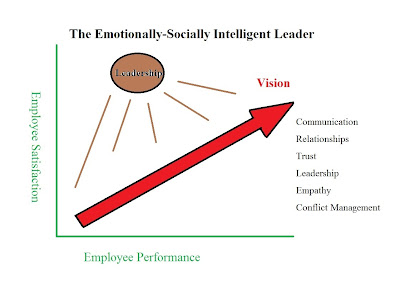Today’s workforce is more global than it was in the past and
has multiple generations working under the same roof. According to a paper in
the International Journal of Information Business
& Management the diverse nature of the work environment we find that
social and emotional intelligence is important for the overall ability to deal with
and relate to people of different backgrounds (Njorge & Yazdanifard, 2014).
Organizations rely on the skills of future managers to create highly functional
and highly diversified workforces that can meet tomorrow’s challenges.
Having emotional and social intelligence is beneficial for
executives and managers that must effectively work with and motivate employees from different backgrounds. Through their ability to act and interact with
various cultures they can help people stay focused on organizational objectives
and command a higher level of multicultural leadership. The management of
global firms requires executives and managers with stronger global capabilities.
It is beneficial to discuss the definitions of emotional and
social intelligence. Emotional
intelligence is the ability to understand, control, and expresses emotions
while creating empathetic relationships with other people. Social intelligence
is the ability to negotiate and navigate complex social environments and create meaning out of these networks.
The ability to relate to other people is a very valuable skill that people often use to further their influence. Bridging two cultures to create networks and influence are extremely difficult as each side has their own way of viewing the world. The more in tune we are with our own emotions we are able to understand others and use social networks to connect to a wider group of people.
Emotional and social intelligence are soft skills that are learned over a long time. You can teach the components to communication, impression, critical thinking, etc... but you can't easily teach someone to tune into the nature of other people. As a soft skill developed over a lifetime it is important for organizations to consider hiring people to meet these in firms where inter-generational and inter-cultural reside. Those executives and managers who have already developed these skills can use these skills to create alignment toward organizational objectives by understanding the different cultural lenses at play within the workplace.
Njorge, C. & Yazdanifard, R. (2014). The impact of social and emotional intelligence on employee motivation in a multigenerational workplace. International Journal of Information, Business & Management, 6 (4).
The ability to relate to other people is a very valuable skill that people often use to further their influence. Bridging two cultures to create networks and influence are extremely difficult as each side has their own way of viewing the world. The more in tune we are with our own emotions we are able to understand others and use social networks to connect to a wider group of people.
Emotional and social intelligence are soft skills that are learned over a long time. You can teach the components to communication, impression, critical thinking, etc... but you can't easily teach someone to tune into the nature of other people. As a soft skill developed over a lifetime it is important for organizations to consider hiring people to meet these in firms where inter-generational and inter-cultural reside. Those executives and managers who have already developed these skills can use these skills to create alignment toward organizational objectives by understanding the different cultural lenses at play within the workplace.
Njorge, C. & Yazdanifard, R. (2014). The impact of social and emotional intelligence on employee motivation in a multigenerational workplace. International Journal of Information, Business & Management, 6 (4).
